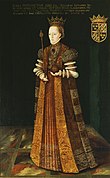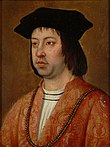1516
Appearance
| Millennium: | 2nd millennium |
|---|---|
| Centuries: | |
| Decades: | |
| Years: |
| 1516 by topic |
|---|
| Arts and science |
| Leaders |
| Birth and death categories |
| Births – Deaths |
| Establishments and disestablishments categories |
| Establishments – Disestablishments |
| Works category |
| Gregorian calendar | 1516 MDXVI |
| Ab urbe condita | 2269 |
| Armenian calendar | 965 ԹՎ ՋԿԵ |
| Assyrian calendar | 6266 |
| Balinese saka calendar | 1437–1438 |
| Bengali calendar | 923 |
| Berber calendar | 2466 |
| English Regnal year | 7 Hen. 8 – 8 Hen. 8 |
| Buddhist calendar | 2060 |
| Burmese calendar | 878 |
| Byzantine calendar | 7024–7025 |
| Chinese calendar | 乙亥年 (Wood Pig) 4213 or 4006 — to — 丙子年 (Fire Rat) 4214 or 4007 |
| Coptic calendar | 1232–1233 |
| Discordian calendar | 2682 |
| Ethiopian calendar | 1508–1509 |
| Hebrew calendar | 5276–5277 |
| Hindu calendars | |
| - Vikram Samvat | 1572–1573 |
| - Shaka Samvat | 1437–1438 |
| - Kali Yuga | 4616–4617 |
| Holocene calendar | 11516 |
| Igbo calendar | 516–517 |
| Iranian calendar | 894–895 |
| Islamic calendar | 921–922 |
| Japanese calendar | Eishō 13 (永正13年) |
| Javanese calendar | 1433–1434 |
| Julian calendar | 1516 MDXVI |
| Korean calendar | 3849 |
| Minguo calendar | 396 before ROC 民前396年 |
| Nanakshahi calendar | 48 |
| Thai solar calendar | 2058–2059 |
| Tibetan calendar | 阴木猪年 (female Wood-Pig) 1642 or 1261 or 489 — to — 阳火鼠年 (male Fire-Rat) 1643 or 1262 or 490 |

Year 1516 (MDXVI) was a leap year starting on Tuesday (link will display the full calendar) of the Julian calendar.
Events
January–June
- January – Juan Díaz de Solís discovers the Río de la Plata (in future Argentina).
- January 23 – With the death of Ferdinand II of Aragon, his grandson, Charles of Ghent, becomes King of Spain.
- March 1 – Desiderius Erasmus publishes a new Greek translation of the New Testament, Novum Instrumentum omne, in Basel.
- April 23 – The Reinheitsgebot is instituted in Ingolstadt, Bavaria, regulating the purity of beer permissible for sale.
July–December
- July – Selim I of the Ottoman Empire declares war on the Mamluk Sultanate of Cairo and invades Syria.
- August 13 – The Treaty of Noyon is signed. Francis I of France recognizes Charles I of Spain's claim to Naples, and Charles recognizes Francis's claim to Milan.
- August 18 - King Francis I of France and Pope Leo X sign the Concordat of Bologna, agreeing on the relationship between church and state in France.
- October 28 – Battle of Yaunis Khan: Ottoman forces under the Grand Vizier Sinan Pasha defeat the Mameluks near Gaza.
- December 4 – Treaty of Brussels: Peace is declared between the Kingdom of France and the Holy Roman Empire.
- c. December – Thomas More's most famous work, Utopia, completed this year, is published in Leuven (in Latin).
Date unknown
- Italian explorer Rafael Perestrello, a cousin of Christopher Columbus, commands an expedition from Portuguese Malacca to land on the shores of mainland southern China, and trade with Chinese merchants at Guangzhou, during the Ming Dynasty.
- Portuguese soldier Fernão Lopes becomes the first known permanent inhabitant of Saint Helena.
- The Venetian Ghetto is instituted, the first ghetto anywhere in the world.
- Leonardo da Vinci accepts Francis I's invitation to France.
- Gillingham School is founded, the oldest in Dorset, England.
- The predecessor of the Royal Mail, known as the Master of the Posts, is established by Henry VIII of England.
- Fuggerei is established in Augsburg (Bavaria), as the world's oldest social housing complex still in use.
- The fall of the Nantan meteorite is possibly observed near the city of Nantan, Nandan County, Guangxi (China).
Births


- January 1 – Margaret Leijonhufvud, queen of Gustav I of Sweden (d. 1551)
- January 14 – Herluf Trolle, Danish admiral (d. 1565)
- January 16 – Bayinnaung, King of Burma (d. 1581)
- February 2 – Girolamo Zanchi, Italian theologian (d. 1590)
- February 16 – Prospero Spani, Italian sculptor (d. 1584)
- February 18 – Queen Mary I of England, daughter of King Henry VIII of England and Queen Catherine of Aragon (d. 1558)
- March 26 – Conrad Gessner, Swiss naturalist (d. 1565)
- April 16 – Tabinshwehti, King of Burma (d. 1550)
- April 23 – Georg Fabricius, Protestant German poet (d. 1571)
- June 28 – Charles Blount, 5th Baron Mountjoy, English courtier and patron of learning (d. 1544)
- July 27 – Emilie of Saxony, German nobleman (d. 1591)
- July 28 – William, Duke of Jülich-Cleves-Berg, German nobleman (d. 1592)
- August 13 – Hieronymus Wolf, German historian (d. 1580)
- September 2 – Francis I, Duke of Nevers (d. 1561)
- September 21 – Matthew Stewart, 4th Earl of Lennox (d. 1571)
- October 4 – Archangelo de' Bianchi, Italian cardinal (d. 1580)
- October 23 – Charlotte of Valois, French princess (d. 1524)
- October 27 – Ruy Gómez de Silva, Portuguese noble (d. 1573)
- November 5 – Martin Helwig, German cartographer of Silesia (d. 1574)
- December 21 – Giuseppe Leggiadri Gallani, Italian poet and dramatist (d. 1590)
- date unknown
- Antonio Bernieri, Italian painter during the Renaissance period (d. 1565)
- John Foxe, biographer (d. 1587)
- Manco Inca Yupanqui, ruler of the Inca (d. 1544)
- Canghali of Kazan, khan of Qasim and Kazan
- Margaretha Coppier, Dutch heroine (d. 1597)
- Shri Gusainji, son of Shri Vallabhacharyaji.
- probable
Deaths


- January 20 – Juan Díaz de Solís, Spanish navigator and explorer (b. 1470)
- January 23 – King Ferdinand II of Aragon (b. 1452)
- February 4 – Anthony of Supraśl, Polish Orthodox priest and saint
- March 13 – Vladislaus II, king of Bohemia, Hungary and Croatia (b. 1456)
- March 17 – Giuliano de' Medici, Duke of Nemours, ruler of Florence (b. 1449)
- April 25 – John Yonge, English diplomat (b. 1467)
- June 14 – King John III of Navarre (b. 1469)
- July 10 – Alice FitzHugh, English heir (b. 1448)
- July 30 – Johann V of Nassau-Vianden-Dietz, Dutch count (b. 1455)
- August 9 (bur.) – Hieronymus Bosch, Dutch painter (b. 1450)
- August 21 – John III of Egmont, Dutch count (b. 1438)
- c. November 26? – Giovanni Bellini, Venetian painter (b. 1430)
- December 13 – Johannes Trithemius, German scholar and cryptographer (b. 1462)
- date unknown – Giuliano da Sangallo, Florentine sculptor and architect (b. 1443)
